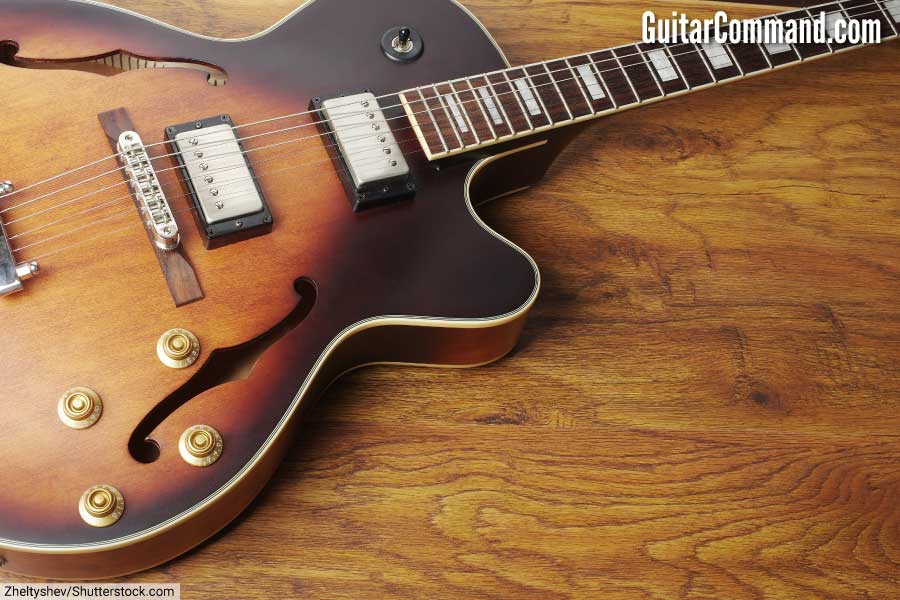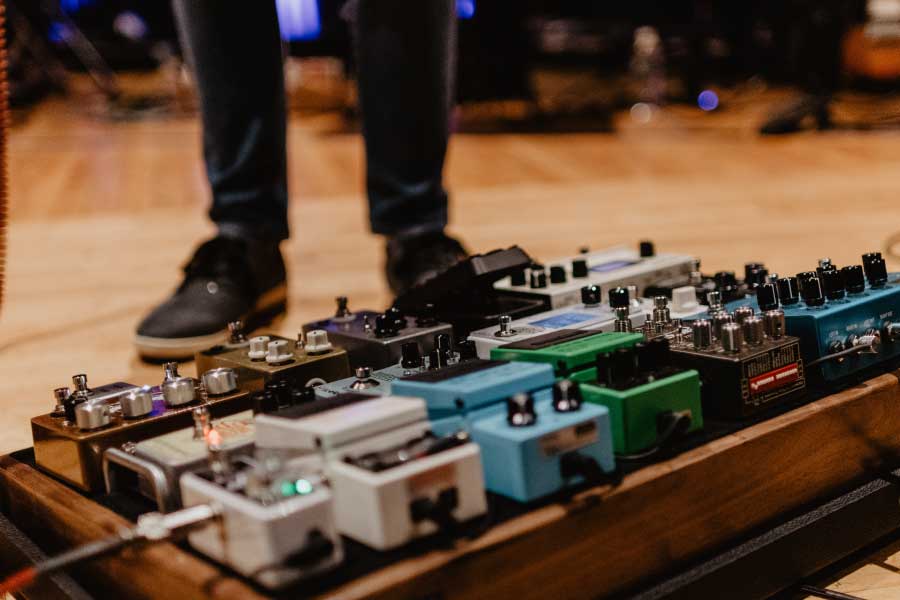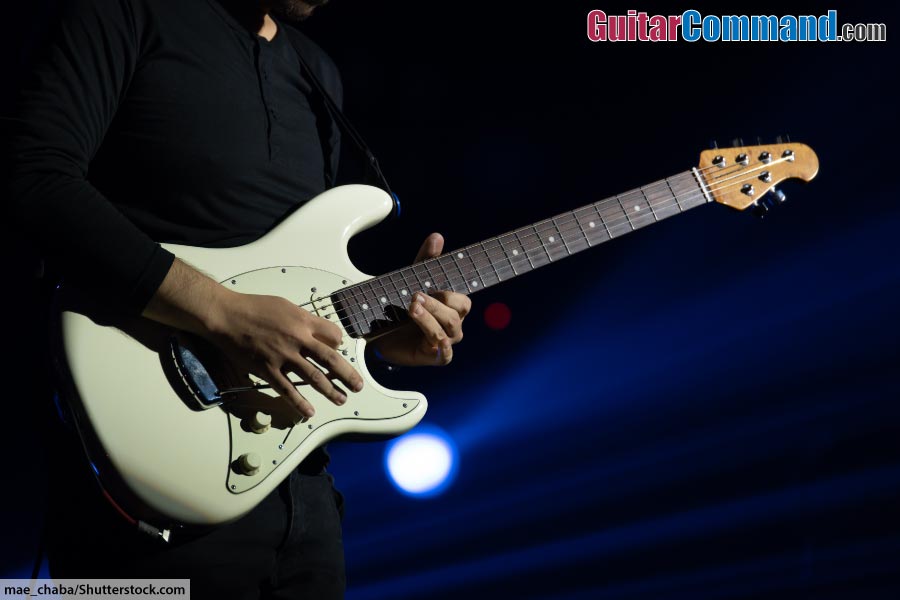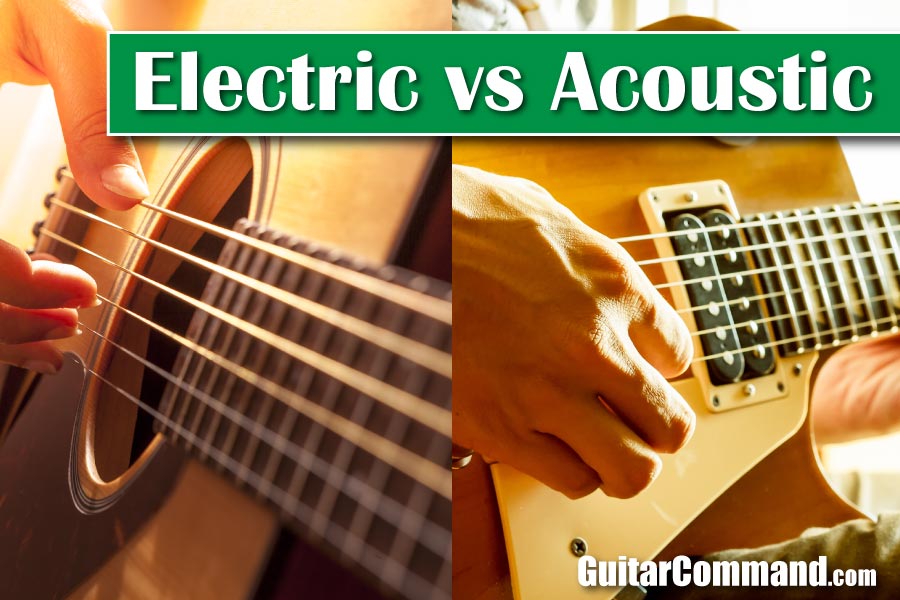Electric vs acoustic guitar: what are the differences between the two instruments? What type of guitar is easiest to play? Which is easiest for a beginner? Which is cheapest?
On this page, we answer all of these questions and more, giving you are complete guide to choosing between an electric or acoustic guitar…
Page Index
The Difference Between Electric and Acoustic Guitar
Physical Differences Between Electric And Acoustic Guitars
Electric Guitar Vs Acoustic Guitar Sound
Electric Guitar Vs Acoustic Guitar Price
Similarities Between Electric & Acoustic Guitars
Which Is Easiest: Electric or Acoustic Guitar?
What Is An Electric Guitar Best For?
What Is An Acoustic Guitar Best For?
Which Type Of Guitar Is Best For A Beginner?
If you have any questions, feel free to ask them in the comments section at the bottom of the page.
The Difference Between Electric and Acoustic Guitar
Electric guitars usually have solid bodies and are equipped with pickups to convert the strings' vibrations into an electrical signal, which is fed via a lead to an external amplifier. An acoustic guitar has a hollow body that amplifies the sound without the need for electronic amplification.

In other words, if you want your electric guitar to make anything other than a barely-audible, metallic sound, you'll need an amplifier to plug it in to! An acoustic guitar, on the other hand, is loud enough to be played without an amplifier.
You can find out more about guitar amps (and see some beautiful classic amps) on this page: Guitar Amp Brands & Famous Amps
Because electric and acoustic guitars produce sound in such different ways, there are numerous other differences between the two types of guitar, not just in the actual sound they produce.
In this guide, we look at the difference between electric and acoustic guitars, comparing their construction, sound, price, and the kind of music each type of guitar is best for.
Below are the key differences between electric and acoustic guitars…
Electric vs Acoustic Guitar
- An electric guitar requires an amplifier to produce a useable sound, while an acoustic guitar produces sound acoustically, without the need for an amp.
- Electric guitars typically have solid bodies (although hollow-bodied electric guitars are available); acoustic guitars have hollow bodies that amplify and project their sound.
- Electric guitars are usually easier to play than acoustic guitars, having thinner strings, lower actions, narrower fretboards and smaller bodies.
- The notes of the fretboard and basic playing styles are the same for both instruments
- Acoustic guitars produce a bright, clear ringing sound.
- Electric guitars produce a mellow, ringing sound that lacks some of the clarity of an acoustic guitar.
- With the use of electronic devices such as effects pedals, an electric guitar can produce an almost unlimited array of tones.
- The sound of an electric guitar can be “overdriven” to produce the crunchy, distorted sounds common in rock and metal music.
- Electric guitars are used in pop, rock and jazz.
- Acoustic guitars are used in folk music, and in folk-influenced pop and rock music.
- Acoustic guitars are prone to feeding back if amplified; electric guitars rarely produce (unwanted) feedback.
- An electric guitar is typically played with a pick; an acoustic guitar is played either with the pick or with the fingers (fingerstyle).
- Acoustic guitars can be played solo, and sound great accompanying a solo singer.
- Electric guitars are rarely played solo, and are usually used in a band.
Physical Differences Between Electric And Acoustic Guitars
An acoustic guitar has a hollow body, with a sound hole positioned in the center of the front of the body, under the strings. The acoustic guitar's hollow body, "top" (the guitar's front panel) and sound hole work together to amplify and project the guitar's sound.

Due to their hollow construction, most acoustic guitars are bigger than electric guitars; not only is the body both wider and deeper, but the neck is also typically a little wider than that of an electric guitar.
This can make an acoustic guitar a little uncomfortable to play.
A typical electric guitar has a slim, solid body, which is often contoured for comfort. The neck of an electric guitar is slimmer than that of a typical acoustic guitar.

Early electric guitars were hollow, or semi-hollow, instruments aimed at jazz and blues players. Most modern players, however, associate the electric guitar with solid-bodied instruments such as the Gibson Les Paul or Fender Stratocaster, which were popularized in the mid-20th century.

Hollow-body, or semi-acoustic, electric guitars still require an amp to produce a useable sound.
Electric guitars, instead of a sound hole (or as well as, in the case of semi-hollow guitars), are equipped with one or more pickups. Pickups are magnetic devices that convert the vibration of the strings into an electronic signal. The pickups are mounted under the strings on the body of the guitar.
Electric guitars are usually fitted with an array of knobs that control the volume and tone of the guitar.
Electric guitars fitted with more than one pickup usually have a pickup selector switch. This allows the player to choose which pickup is currently being used. (A pickup positioned near the guitar’s bridge produces a bright sound; a pickup near the neck produces a warm sound).
These days, many acoustic guitars are designed with built-in microphones or pickups to allow you to play them through an amplifier or PA. Even these “electro-acoustic” guitars don’t sound like, or play in the same way, as true electric guitars.
Some electric guitars are even designed with “hybrid” technology allowing you to make a semblance of acoustic tone using the electric guitar. This type of guitar has its uses, but is not a substitute for a proper acoustic guitar.
Electric Guitar vs Acoustic Guitar Sound

Acoustic guitars have a distinctively bright, but “woody” tone. This is because, when you play an acoustic guitar without any amplification, all you are hearing is the natural resonance of the strings and the wood from which the guitar is made.
An electric guitar played clean (i.e., without any distortion), and without any effects, produces a mellow, ringing sound. The controls on the guitar itself can determine the color of this sound, which can be further modified by the amp’s controls and with the use of electronic effects.
The main difference between the sound of an acoustic guitar and that of an electric guitar is that an acoustic guitar only really produces one tone, while an electric guitar (with the aid of an amp and effects) can produce a nearly endless variety of tones.
In fact, it’s not uncommon to hear a variety of sounds from one electric guitar during the course of the same song!
Think of Nirvana’s “Smells Like Teen Spirit”, which features a dry clean sound, a big, distorted sound, and a warbling, phased-out lead guitar tone. All those tones were made using the same Fender guitar and a variety of pedals.

Electric guitars can produce a wide range of different sounds, from the percussive, clicky clean tone of Mark Knopfler to the take-no-prisoners distorted sound of Metallica.
Electric Guitar vs Acoustic Guitar Price
As a general rule, acoustic guitars are more expensive than electric guitars of equivalent quality because they are harder to build.
Constructing an acoustic guitar requires more time, effort, and expertise, because it is made of many different pieces of wood, all of which must be shaped and joined together.
By comparison, even high-end electric guitars, such as Fender’s iconic Stratocaster, were designed to be made in factories in large quantities, and are relatively simple in their construction.
That’s not to say great electric guitars are not made by extremely skilled professionals, and that there are no decent, mass-produced, affordable acoustic guitars available. The reality is, however, that the intensive labor requirements for making a great acoustic guitar are reflected in their pricing.
That said, giant manufacturers such as Yamaha and Ibanez are able to mass-produce perfectly good acoustic guitars under $300, but in this price range there are more electric guitars on the market due to their comparatively cheap manufacturing costs.
Yamaha's FG820, for example, is a well-regarded beginner / intermediate acoustic guitar.
- Solid Sitka Spruce Top
- Mahogany Back & Sides
- Rosewood Fingerboard
- Rosewood Bridge
- Diecast Tuners
A decent, beginner electric guitar can be had for under $250. The Yamaha PAC012, for example, would make a great first guitar.
- Agathis Body
- Maple Bolt-On Neck
- Sonokeling Fingerboard
- Vintage Tremelo
- 5 Position Switch
You can get a pro-quality electric guitar for under $1,000, and a top-of-the-range one for under $2,000. On the other hand, high quality acoustic guitars, such as the top-end offerings from Martin or Taylor, will easily set you back over $3,000... or more!
- Antique white binding Aging toner Forward shifting non-scalloped X bracing Dovetail neck joint Style 28 mother-of-pearl fingerboard inlays Solid headstock with square taper and diamond inlay. SP Acoustic 92/8 Phosphor Bronze Medium (MSP4200) strings Multi-stripe top and back inlays
- Sometimes innovation is in the details and this is certainly true with Martin’s re-imagined 2017 D-28
- After nearly a century at the helm, and as the quintessential workhorse of music legends like Hank Williams, The Beatles, Johnny Cash, Neil Young, Bob Dylan, and so many more, Martin's legendary D-28 has been lovingly and artfully enhanced
- “The post WWII D-28 had a slightly different look than its predecessor and became the centerpiece of the folk and folk rock movements at their pinnacle in the 1950s and 1960s
- " says Chris Martin, Chairman and CEO of Martin Guitar, "We have extracted the finest features from the D-28 of both my grandfather’s and my father’s respective eras
You can find out more about the cost of a new electric guitar on this page: How Much Is An Electric Guitar?
Similarities Between Electric & Acoustic Guitars
Playing-wise, electric and acoustic guitars are more alike than they are different. As a general rule, the tunings are the same, basic technique for picking and fretting applies to both, and the music theory for chords and melodies is applicable to both as well.
If you are a competent player on acoustic, odds are you can play electric guitar reasonably well, and vice versa.
At the end of the day, both are guitars.
At a more advanced level, it is worth noting that there are techniques that are only really used on one type of guitar.
Electric players need to sharpen their muting technique in a way that acoustic players do not. String bending is a technique not often used on acoustic guitar, but it is very common for electric players.
Fingerstyle – playing with the fingers rather than with the pick – is a technique far more commonly employed on acoustic guitar.
Playing fingerstyle allows you to play solo pieces that have independent melodies and accompaniment. This is possible due to the more nuanced sound of an acoustic guitar, and simply don’t sound that great when tried on an electric guitar.
Which Is Easiest: Electric or Acoustic Guitar?

The relatively narrow neck, thin body and low action (the distance between strings and frets) of an electric guitar make it easier to play than an acoustic guitar for a beginner. Until your fingertips harden up and your hand gains strength, playing acoustic guitar can be quite tough physically - although you will get through the painful first stages eventually!
Therefore, if you’re just starting out, it’s probably easier to learn the basics on an electric guitar.
However, neither electric nor acoustic guitar is so much easier that it’s worth neglecting the other for. If you’re more interested in the sound of one or the other, you should play that type of guitar. There’s really no right or wrong answer here, and it’s down to your own personal preference.
What Is An Electric Guitar Best For?
You can hear the electric guitar in virtually all modern forms of popular music. Rock, pop, jazz, blues, country, hip-hop, disco, funk, and heavy metal all feature the electric guitar. The electric guitar was one of the defining sounds of popular music as we know it.
The electric guitar is probably most associated with the rock genre and its various offshoots like metal and punk. It’s not a blanket rule, but generally speaking, you can expect the electric guitar to be a major feature of more upbeat styles of music.
What Is An Acoustic Guitar Best For?
In recent years, the acoustic guitar has become extremely popular in pop music. Ed Sheeran, one of the biggest pop stars in the world, exclusively plays acoustic guitars.
Acoustic guitar is commonly used in many genres of music, but the softer, warmer tones of the acoustic guitar are more closely-associated with soft rock, folk, and country music than they are with the aggression of high-voltage rock and roll.
You can hear acoustic guitar on jazz and blues records, too, although it’s common for proficient players in those genres to play both acoustic and electric guitars.
Which Type Of Guitar Is Best For A Beginner?
Although an electric guitar is slightly easier to play at the start, this shouldn't be a major factor in your decision. Instead, select the guitar that's most suited to playing the music you love.
If you want to play rock, blues, metal or funk in a band, then you should get an electric guitar. If you want to play folk or folk-influenced rock or pop, or if you want to play solo fingerstyle pieces, then acoustic guitar is the instrument for you.
If you want to play all styles of music, then we recommend you start on an electric guitar. Playing electric guitar is a lot easier on the fingers at the start.
The one disadvantage of starting out on electric guitar is that you’ll need an amplifier and a lead to connect the guitar to the amp. If you play acoustic guitar, all you need is the guitar itself!

Most of the big guitar companies sell beginner electric guitar packages that contain a guitar and an amp, plus a lead, picks and often a few other accessories:
- Modern C-neck for the ultimate play comfort
- Tune into a variety of modes effortlessly with the 2-point tremolo system
- Be it the combination of middle and neck, or a bridge pickup, the single coils make this a breeze
- Easy adjustment with the two point system
- Included Fender Frontman 10G amplifier delivers full sound from its 6" speaker, with a gain control and overdrive switch that rock guitar tones from tube-emulated overdrive to full-strength ultra-saturated distortion - perfect for blues, metal and famous Fender clean tone
Another factor worth considering is that you can upgrade a cheap electric guitar to improve its performance more easily than an acoustic guitar. You can, for example, swap out the pickups in your beginner electric for more expensive pickups, and improve its tone that way.
One bonus of acoustic guitars is that they are better-suited to traveling because they are self-contained. You can’t (easily) play an electric guitar round a camp fire!
Electric vs Acoustic Guitar: TL;DR Conclusion
If you want to play rock music in a band then there is only one choice: an electric guitar. If you're more interested in playing folk music or folk-inspired pop or rock music, or if you want to be a solo singer / songwriter, then acoustic guitar is the way to go.
Don't spend too much time choosing whether to get an electric or an acoustic guitar – make your decision and get playing! You can always change over at a later date!






